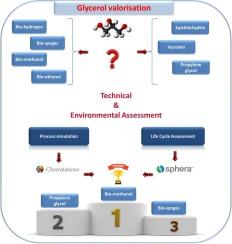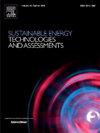Towards value-added chemicals: Technical and environmental life cycle assessment evaluation of different glycerol valorisation pathways
IF 7.1
2区 工程技术
Q1 ENERGY & FUELS
Sustainable Energy Technologies and Assessments
Pub Date : 2024-10-25
DOI:10.1016/j.seta.2024.104043
引用次数: 0
Abstract
Biodiesel is acknowledged as the most appropriate biofuel to decarbonise the transport sector and combat climate change. The ever-increasing biodiesel production via transesterification results in large amount of glycerol (e.g., 10 kg of glycerol for every 100 kg of biodiesel). Converting glycerol into value-added goods is perceived to be a viable way to lower the high cost of producing biodiesel and expand its market share. The current study examines the technical and environmental aspects of bio-hydrogen, bio-syngas, acrolein, propylene glycol, epichlorohydrin, bio-methanol and bio-ethanol synthesis. CHEMCAD process simulation software was used to perform the modelling and simulation aspects considering a glycerol flowrate of 100 kg/h. The environmental study is based on primary and secondary data and is carried out using the Life Cycle Assessment methodology and the LCA for Experts software, using ReCiPe as the impact assessment method. The technical evaluation points towards glycerol conversion to propylene glycol and bio-methanol production as the best approaches given the relatively low energy requirements, increased purity (>97 wt%) and steadily growing product market. Bio-methanol exhibits the best environmental performance among all examined scenarios, providing the lowest impact in eight out of eleven categories studied while placing second in terms of FETP impact. Glycerol conversion towards propylene glycol seems as the second-best conversion route as it generates the lowest score in regards to GWP impact (0.31 kg CO2 eq./ kgproduct). Ultimately, the most effective methods for valorizing glycerol and improving the production of biodiesel by lowering the expenses related to its manufacturing are glycerol reforming toward bio-methanol and propylene glycol.

实现化学品增值:不同甘油价值化途径的技术和环境生命周期评估评价
生物柴油是公认的最适合运输行业脱碳和应对气候变化的生物燃料。通过酯交换法生产的生物柴油不断增加,产生了大量甘油(例如,每 100 千克生物柴油产生 10 千克甘油)。将甘油转化为增值产品被认为是降低生物柴油生产的高成本并扩大其市场份额的可行方法。本研究探讨了生物氢、生物合成气、丙烯醛、丙二醇、环氧氯丙烷、生物甲醇和生物乙醇合成的技术和环境问题。考虑到甘油流量为 100 公斤/小时,使用 CHEMCAD 工艺模拟软件进行建模和模拟。环境研究以第一手和第二手数据为基础,采用生命周期评估方法和 LCA for Experts 软件,以 ReCiPe 作为影响评估方法。技术评估结果表明,甘油转化为丙二醇和生物甲醇生产是最佳方法,因为它们的能源需求相对较低,纯度更高(97 wt%),产品市场稳步增长。在所有研究方案中,生物甲醇的环境绩效最佳,在研究的 11 个类别中,生物甲醇对 8 个类别的影响最小,而在 FETP 影响方面,生物甲醇位居第二。甘油转化为丙二醇似乎是第二好的转化途径,因为它在全球升温潜能值影响方面得分最低(0.31 千克二氧化碳当量/千克产品)。归根结底,甘油转化为生物甲醇和丙二醇是最有效的甘油增值方法,也是通过降低生物柴油生产成本来提高生物柴油产量的最有效方法。
本文章由计算机程序翻译,如有差异,请以英文原文为准。
求助全文
约1分钟内获得全文
求助全文
来源期刊

Sustainable Energy Technologies and Assessments
Energy-Renewable Energy, Sustainability and the Environment
CiteScore
12.70
自引率
12.50%
发文量
1091
期刊介绍:
Encouraging a transition to a sustainable energy future is imperative for our world. Technologies that enable this shift in various sectors like transportation, heating, and power systems are of utmost importance. Sustainable Energy Technologies and Assessments welcomes papers focusing on a range of aspects and levels of technological advancements in energy generation and utilization. The aim is to reduce the negative environmental impact associated with energy production and consumption, spanning from laboratory experiments to real-world applications in the commercial sector.
 求助内容:
求助内容: 应助结果提醒方式:
应助结果提醒方式:


